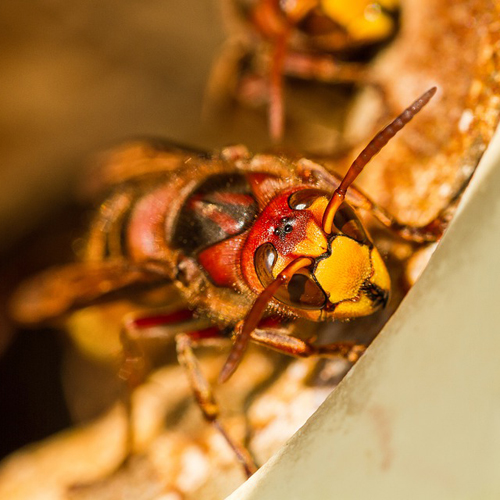HORNETS

Scientific Name: Vespa crabo
Appearance
- Size: The adult European hornets are approximately 1-1.5 inches long. Queens are the largest member of the hornet colony.
- Wings and Legs: Hornets have two pairs of wings and six legs.
- Color: Dolichovespula maculata, the bald faced hornet, resembles a larger version of a common yellow jacket, except they have whitish-colored facial, thoracic, and abdominal markings. European hornets have a reddish-brown head, thorax, first abdominal segment, and legs.
Common Types of Hornets
- European hornets
- Bald faced hornets
Behavior, Diet & Habits
European hornets are not as aggressive as bald faced hornets, but will nevertheless sting if their colony is disturbed. Hornet nests can be found in locations, such as:
- Attics
- Porches
- Inside wall voids
- Tree branches or hollows
- Thick bushes
Life Cycle
Growing Colonies
Colonies usually have an annual life cycle. Colony success depends on the ability of hornet queens to survive the cold weather of winter. Fertile hornet queens begin building new nests in the spring and also start laying eggs. As the eggs hatch and become hornet grubs (larvae), queens works to enlarge the nest. This is done by hunting for insects to feed to larvae.
In time, larvae mature, go through a pupal stage, and develop into the first generation of adults. At this point, queens cease work enlarging the nest to focus on laying eggs. The first and subsequent generations of hornet workers assume the role of nest builders, protectors, and food gatherers for the remaining members of the colony.
How Serious Are Hornets?
When hornets perceive threats near their nests, they become aggressive and can deliver painful stings. Angered hornets can also squirt venom into the eyes of enemies, causing temporary blindness. While their stings typically cause no long-term damage, the pain from stings is intense and people allergic to their venom may have serious medical reactions.
Sting Reactions
When someone is stung multiple times or is highly allergic to the insect’s venom, there can be systemic reactions that may affect the entire body. Typical symptoms and reactions to stings are:
- Intense pain
- Redness
- Swelling around the site of the sting
Signs of Infestation
The most obvious signs of a hornet problem are presence of adults and nests. During the time that nests are being built, it is common to see hornets scraping away a thin layer of wood from a wooden fence, an old log, or the side of an unpainted wooden building.
How to Get Rid of Hornets?
The first step in hornet control is to identify the pest. Once that is determined, your pest control technician will develop a specific treatment plan for your individual needs. While sometimes possible, it usually isn’t wise to attempt any do-it-yourself efforts. Complete control may require more than one treatment visit to ensure all of the pests are eliminated.
Contact Better Care today to get rid of your bee, wasp and hornet problem and eliminate any stress or pest concerns you have in your home or business.

